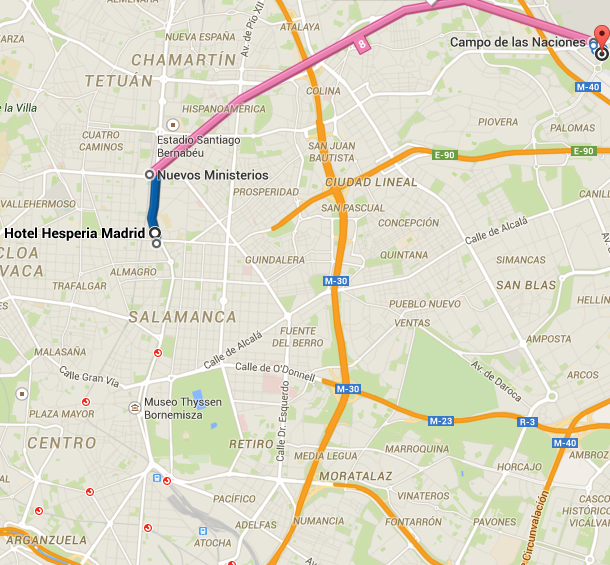SINBAD Consortium Meeting - Spring 2015
Madrid, Spain
June 5, 8:30 AM - 4:30 PM
Venue:
Hesperaria Madrid
Paseo de Castellana,
57 28046 - Madrid
Ph: +34 912 108 800.
To Register:
Email: slim-assist@eos.ubc.ca
Call: +1 604 822 5674
Madrid, Spain
Friday June 5, 8:30 AM - 4:30 PM
Venue: Hesperaria Madrid, Paseo de Castellana 57
Directions to our venue:
From IFEMA or airport metro stations: take the “8 pink” metro line. Disembark at Nuevos Ministerios, and walk for 10 min due south along the Paseo De Castellana. You will shortly pass the historic Museum of Natural Sciences on your left, and the Hesperaria at 57 Paseo de Castellana will be soon after on your right. On google maps
From downtown: take the “10 blue Hospital Infanta” metro line, at one of the following stations: Colonia Jardin, Casa de Campo, Batan, Lago, Principe Pio or Plaza de Espana. Disembark at the Gregorio Maranon station, and the Hesperaria Hotel will be directly in front of the station. On google maps
Please call +1 778 861 5302 if you have any trouble finding the venue, or call hotel reception at +34 912 108 800
 |
 |
 |
SINBAD II Supporting Companies
BG Group
BGP
CGG
Chevron
ConocoPhilips
DownUnder GeoSolutions
Hess
Petrobras
PGS
Schlumberger
Woodside
Participants from Supporting Companies:
Daniel Bright (BG Group)
Tim Burgess (DownUnder GeoSolutions)
Nizar Chemingui (PGS)
Thomas Elboth (CGG)
Lluis Guasch (Sub Salt Solutions)
Fabien Marpeau (CGG)
Bjorn Muller (DownUnder GeoSolutions)
Kenton Prindle (Woodside)
James Selvage (BG Group)
Risto Siliqi (CGG)
Fei Allen Sun (CGG)
Troy Thompson (DownUnder GeoSolutions)
Chu-Ong Ting (CGG)
Alejandro Valenciano Mavilio (PGS)
Yi Xie (CGG)
Gang Yao (Sub Salt Solutions)
Guests:
Adrian Umpleby (FullWave)
Nuno Vieira Da Silva (Fullwave)
Mike Warner (Fullwave)
Participants from SLIM:
Felix Herrmann (Director, SLIM)
Curt Da Silva (PhD, Math/SLIM)
Zhilong Fang (PhD, SLIM)
Rajiv Kumar (PhD, SLIM)
Oscar Lopez (PhD, Math/SLIM)
Felix Oghenekohwo (PhD, SLIM)
Bas Peters (PhD, SLIM)
Haneet Wason (PhD, SLIM)
Program 2015 SINBAD Spring Consortium meeting
Friday June 5, Madrid, Spain, Hesperaria Madrid “Tapies Room”, Paseo de Castellana 57, 28046 Madrid
Automatic salt delineation — Wavefield Reconstruction Inversion with convex constraints
[Ernie Esser] (posthumously presented by Felix J. Herrmann)
Abstract. We extend full-waveform inversion by Wavefield Reconstruction Inversion by including convex constraints on the model. Contrary to the conventional adjoint-state formulations, Wavefield Reconstruction Inversion has the advantage that the Gauss-Newton Hessian is well approximated by a diagonal scaling, which allows us to add convex constraints, such as the box- and the edge-preserving total-variation constraint, on the square slowness without incurring significant increases in computational costs. As the examples demonstrate, including these constraints yields far superior results in complex geological areas that contain high-velocity high-contrast bodies (e.g. salt or basalt). Without these convex constraints, adjoint-state and Wavefield Reconstruction Inversion get trapped in local minima for poor starting models.
Regularizing waveform inversion by projections onto convex sets
Abstract. A framework is proposed for regularizing the waveform inversion problem by projections onto intersections of convex sets. Multiple pieces of prior information about the geology are represented by multiple convex sets, for example limits on the velocity or minimum smoothness conditions on the model. The data-misfit is then minimized, such that the estimated model is always in the intersection of the convex sets. Therefore, it is clear what properties the estimated model will have at each iteration. This approach does not require any quadratic penalties to be used and thus avoids the known problems and limitations of those types of penalties. It is shown that by formulating waveform inversion as a constrained problem, regularization ideas such as Tikhonov regularization and gradient filtering can be incorporated into one framework. The algorithm is generally applicable, in the sense that it works with any (differentiable) objective function and does not require significant additional computation. The method is demonstrated on the inversion of the 2D marine isotropic elastic synthetic seismic benchmark by Chevron using an acoustic modeling code. To highlight the effect of the projections, we apply no data pre-processing.
Wavefield reconstruction inversion with source estimation and its application to 2014 Chevron synthetic blind test dataset
Abstract. We present a robust wavefield reconstruction inversion with source estimation. The source wavelet is estimated with the reconstruction of wavefield simultaneously by solving an extended data augmentation problem. We apply this method to the 2014 Chevron synthetic blind test dataset and show the robustness of our method.
Mitigating local-minima via low-rank extensions of Wavefield Reconstruction Inversion
Abstract. We present the low-rank extensions of full-waveform inversion to mitigate the local-minima issues. The purpose formulation is computationally tractable and does not involve any extra computational cost compared to the adjoint-state method.
Solving WRI’s data-augmented wave equation in 3D
Abstract. The Wavefield Reconstruction Inversion (WRI) approach to seismic inversion is a topic of active research in the SLIM group. Several variants have been proposed, all of which rely on the solution of a linear least-squares problem with a Helmholtz discretization. While algorithms based on LU or QR factorization are very efficient for 2D problems, 3D problems required the development of a factorization-free iterative method. This talk introduces the current version of the algorithm, which requires significantly less memory and computation then a few months ago and uses existing Helmholtz solvers as an important building block.
Recent improvements to the 2/3—D imaging & inversion algorithms in the SLIM software release
Abstract. The SLIM software release contains algorithms for frequency domain 2D imaging and inversion based on direct LU and QR factorizations. Recent improvments include significant speedups, by utilizing the latest parallel direct factorization algorithms and inversion strategies which solve for each frequency on its corresponding grid. The iterative Helmholtz solvers available in the software release are now also applicable to 2D problems, extending the 2D algorithms to very large & high frequency 2D imaging and inversion.
Fast “online” migration with Compressive Sensing
Abstract. We present a novel adaptation of a recently developed relatively simple iterative algorithm to solve large-scale sparsity-promoting optimization problems. Our algorithm is particularly suitable to large-scale geophysical inversion problems, such as sparse least-squares reverse-time migration or Kirchoff migration since it allows for a tradeoff between parallel computations, memory allocation, and turnaround times, by working on subsets of the data with different sizes. Comparison of the proposed method for sparse least-squares imaging shows a performance that rivals and even exceeds the performance of state-of-the art one-norm solvers that are able to carry out least-squares migration at the cost of a single migration with all data.
Latest developments in randomized marine acquisition and source separation
[Haneet Wason]
Abstract. We present the latest developments in randomized (simultaneous) marine acquisition for time-lapse surveys. We also show a comparison between two source separation algorithms — sparsity-promotion and rank-minimization — for simultaneous data.
Recent developments in compressive sensing for time-lapse studies
Abstract. We present an overview of the advances we have made with respect to extending compressive sensing ideas to time-lapse studies. We show applications in compressive time-lapse seismic data acquisition, imaging and full-waveform inversion.
Off the grid tensor completion for seismic data interpolation
Abstract. In this work, we extend our previous low-rank tensor techniques for seismic data interpolation to the “off-the-grid” case, wherein the data is not acquired on a regularly-spaced grid. This irregular sampling scheme causes the underlying tensor to become high-rank, thus preventing our previous Hierarchical Tucker tensor algorithms from successfully recovering the volume. Instead of applying these techniques naively, we introduce a fictitious, regular grid on which the volume exhibits low-rank behaviour and a resampling operator that interpolates the data from the regular, low-rank domain to the irregular sampling domain. By incorporating these changes in to our previous framework, we can interpolate irregularly sampled data volumes with costs determined primarily by the choice of resampling transform. In our case, we use a non-uniform Fast Fourier Transform, but other choices are possible.
Deterministic Matrix Completion: applications to seismic trace interpolation
Abstract. This talk discusses recent developments in the theory of matrix completion that allow us to analyze how successful a given sub sampling scheme will be for seismic trace interpolation via nuclear norm minimization. By adopting a graph theory perspective, we utilize the spectral gap of our sampling operator as a means to quantify our acquisition design. This approach offers a heuristic technique that is practical and with the potential to achieve trace interpolation via rank penalization in a deterministic manner.
Presented posthumously by Felix J. Herrmann↩


